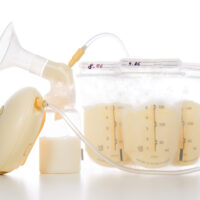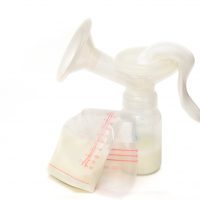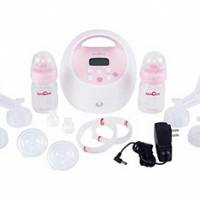Breastfeeding may be natural, but that does not make it easy. If your baby isn’t latching on well, you are probably wondering how to get your baby to latch deeper onto the breast for a good feed. I will share techniques that worked for me plus other tips from experts.
I breastfed all three of my children past the one-year mark, but I really didn’t know if I was going to make it through the first couple of days home from the hospital with my oldest. It seemed like she was feeding well in the hospital, but at home, she either quickly fell asleep suckling, or just cried. I could not get her to latch and feed well.
Luckily, our hospital had great lactation consultants who were able to help a lot when we went back for an appointment, but those first 48 hours at home were awful. If you are waiting for professional help or don’t have it available in your area, I want to share what I learned to get a good, deep latch.
1. Find a Comfortable Position for You and Baby
There are many different ways to position yourself and your baby that will allow you to achieve a good latch. Though some experts recommend new moms start breastfeeding while sitting up and well supported, I think it’s more about giving you a good view and better control than about it working best for everyone.
While it might be good to try sitting mostly upright at the start, you can also look for ways that are comfortable for both of you and safe for baby.
Besides the classic way to hold your baby in front of you while you sit up, you can also support your baby to your side or even over your shoulder as you sit or lie back a bit. Laying down on your side might also be a good choice for you and your baby as long as you can stay awake to monitor your child.
There really isn’t a wrong way to be as long as you both are comfortable and your baby can breathe and easily reach the breast.
The most important takeaway here: You want to bring the baby to your breast rather than trying to move your breast to the baby. Try a few positions and see what works best for you both right now. It will probably change later on!
A nursing pillow, such as a Boppy, may help you get into a comfortable position. Here are our favorite nursing pillows.
2. Hold Your Breast Correctly
Making your hand into a C, pinch the breast around the areola. Your thumb will be on top and your other fingers beneath. This compresses your breast and helps create a good shape for baby’s mouth. Some moms may also use the U hold, which is very similar, except you are supporting the breast from the underside.
The goal here is to get the breast supported and to get the nipple in a place and angle where baby can easily access it. Remember, don’t hold your breast too close to the nipple because you want to leave plenty of surface space for baby to get the deep latch and take in the whole nipple, areola included, for a feeding.
3. Line Up Your Baby
Though it may seem like you’d want your baby’s mouth to line up with the nipple, you actually want to have her nose or just above her upper lip lined up with your nipple before getting her to latch on deeply.
You will want to hold the back of your baby’s head gently. Tip her head back a bit so her chin juts forward. Your baby’s chin may naturally stay back, which means her lower jaw won’t be positioned correctly.
If she is lined up correctly, she will be able to take more of the breast in with her tongue, which helps create a good, deep latch and flow of milk.
4. And Latch!
When your baby opens his mouth very wide, you should quickly move into action. Starting with his lower jaw, you will gently roll his face on to the nipple. Place the bottom lip or jaw on the breast first at the close edge of the areola. Then quickly tip the back of his head forward to place his top lip on the far side of your nipple.
Keep your breast compressed until your baby’s upper jaw is successfully placed. Then you can stop compressing your breast as your baby feeds.
If your baby tends to not open his mouth very wide, you may need to spend some time teaching him how. Position him for a feeding and touch his upper lip to your nipple. Then move him back a bit. Repeat until he opens wide enough to cover most of the areola.
Signs of a Good, Deep Latch
Once you’ve gotten everything situated and put baby to the breast, you can easily tell if there’s a deep latch or a shallow latch. Here’s what you should watch for:
- Check to make sure baby’s nose isn’t buried in your breast. You want her nose touching you but not blocked.
- Look to see if you can see her lips. If you can’t see the pink, her lips are probably turned inward. You want her lips outward.
- You also want a good seal between her lips and your skin. If you can put your finger in her mouth as she feeds, she isn’t latched well enough.
- Check how much areola you can see. You want most of it to be inside baby’s mouth. If she has just the nipple, it will become painful and she won’t get as much milk.
- See if your baby’s tongue is between her lower jaw and the breast. You may be able to feel it, but you can also try to pull down her lower lip a bit and see it. If you hear clicking sounds, that means baby’s tongue is probably not in the right spot.
If any of these things don’t seem right, gently remove your baby and try again. Even if she seems happy with the feed, an improper latch can cause pain and damage to your breast and result in a poor feed. It’s worth taking the time to start again.
Practice Makes Perfect
It takes repetition to be able to quickly get baby positioned and moved correctly onto your breast. It can be hard to be patient when you and your baby are both tired and frustrated, but try to remember that it takes practice and you will both get it if you keep at it.
After some successful feeds, you will know what it feels like to have your baby latched on well. The process will become second nature after a while.
If you have tried multiple times and don’t feel like you are making any progress, it is time to seek out a lactation consultant to help. If you don’t have access to one through your hospital or birthing center, you can find a local lactation consultant.
How to Tell if Baby is Getting Enough Milk
Once you know your baby has a good, deep latch, you have cleared a major hurdle. But the next thing you might wonder about is how to tell if your baby is getting enough milk. Latching well definitely helps your baby make the most of each feeding, but there are other signs to look out for.
Weight Gain
A major indication of whether baby is getting enough to eat is if he is gaining weight. While it is normal for newborns to lose up to 10% of their birth weight in the first few days of life, you want them to be gaining weight by your first pediatrician appointment and back to their birth weight within two weeks. After that, they should continue to gain weight every week.
The rule of thumb I learned was that babies should double their birth weight by 5 to 6 months and triple it by their first birthday. So they are growing faster in those first months than they will be in the second half of their first year.
That weight gain translates to about 5-7 ounces a week in the first five months and 3-5 ounces a week until the first birthday, according to the Mayo Clinic.
Of course, you probably won’t be seeing baby’s doctor for a weigh-in every week, and the scale you use for yourself probably won’t be that precise. You could invest in a baby scale if you want to be sure, but seeing growth at each doctor appointment will probably be fine if all other signs point to him getting enough milk.
I was lucky to have a great breastfeeding support group that met weekly near my house, and they had a good baby scale to do weekly weigh-ins. It was very reassuring to me as a new mom.
Watch Diapers
After day 4 of baby’s life, you want to see 6 or more wet diapers a day and 3 to 4 bowel movements as indicators that baby is getting enough to eat. On day 1, there will probably be only one wet diaper, but they should increase through the first few days to 6 or more.
By day 5, you want to see “regular” stools instead of the dark meconium that is expelled after birth. A breastfed baby’s stools are usually on the thin and runny side, yellow, and seedy looking. They should be at least as big as a US quarter.
Baby is Satisfied
It is also a good sign if your baby seems fairly content after a 15-20 minute feeding. If he was still hungry, he would probably let you know! But there are some babies who are just pretty chill, so if the other signs aren’t being met, don’t put too much stock in baby’s contentment.
Changes in Breasts
You should also feel changes in your breasts after a good feeding. They should feel softer and less full. Engorgement can be a problem with a shallow latch, so after a good feeding with a deep latch, you should see those lumps of milk in the breast disappear or go down significantly.
Supply Problems?
While many moms worry that their milk supply is low, it is not truly a very common problem for moms who are nursing often. If your baby is gaining weight and producing wet and dirty diapers, you are making enough milk for them. And one of the best ways to ensure you are making enough milk is to nurse your baby often and avoid supplementing with formula unless medically necessary. Read more about how to tell if your supply is low and how to fix it.
How to Find More Help With Baby’s Latch
Sometimes breastfeeding is just hard, and you might need more information or support. We have some tips for successful breastfeeding and helpful products:
Online Resources
There are some other websites with really helpful information for your breastfeeding journey. I used KellyMom a lot when I was breastfeeding. They have articles and tips on all sorts of pregnancy, breastfeeding, and parenting issues. Here is an article with latch resources from KellyMom.
La Leche League International and AskDrSears.com also have helpful resources for latching and other breastfeeding issues.
In-Person Resources
But sometimes reading all the tips the internet has to offer just isn’t enough. Sometimes you need someone to sit with you and your baby (or maybe visit you virtually) to guide you through the process. Or you need a group of breastfeeding moms to support you.
If you don’t know of a lactation consultant or support group near you, use these links to find local options:
I was so fortunate to have great lactation consultants and a support group in my area. The hospital I delivered in had two lactation consultants on staff who worked with me right after delivery and at an appointment later on. They also ran a weekly support group for moms so we could ask questions and discuss all aspects of breastfeeding. I really don’t think I could have nursed as long and successfully as I did without these resources.
You Can Do This!
So take it from a veteran of breastfeeding (one child and I went 20 months), you can do this! Keep practicing, seek help, and remember all the benefits you are giving your baby through this experience. Once you know how to get your baby to latch deeper, you are well on your way to long-term breastfeeding success.







